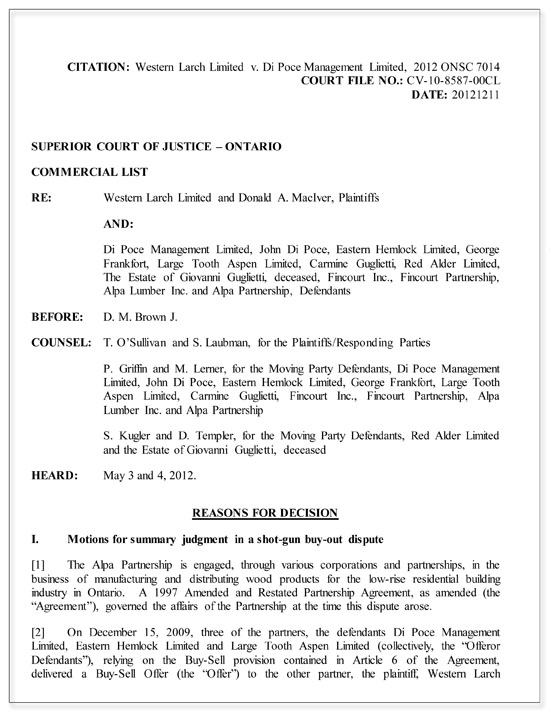Scheduling protocols for judges have to take into consideration increasingly complex motions that consume more time than allotted, says Ontario Superior Court Justice David Brown.

In his ruling this week in
Western Larch Ltd. v. Di Poce Management Ltd., “a shot-gun buy-out dispute,” Brown broke down the number of hours it took him to make the decision.
“For the first time since my appointment to the bench, I kept a docket of the time which I spent on writing a judgment,” he says. “I spent 75 hours writing these reasons.”
The current Superior Court scheduling protocols allot 35 weeks of sitting a year each judge. That is 175 day or 875 hours, notes Brown. He adds hearing the motion in this specific case took almost one per cent of his annual sitting time.
Each judge is also given nine weeks in one year to write judgments. If a judge writes for eight hours a day, that makes 360 hours of allotted judgment writing time, Brown writes.
“These reasons took 75 hours to write, or 21 per cent of my annual judgment writing time. Of course most judges use part of their vacation to write reserve judgments, but I will put that issue to one side,” he adds.
The court is now faced with complex summary judgment motions and much of factual review of these complex motions occurs after the hearing.
“Yet, at the same time that judges are asked to hear complex summary judgment motions, they also are called upon to hear and decide quickly numerous intervening urgent motions and applications,” he writes. And prioritizing urgent cases means a delay in adjudication of less urgent but complex matters.
“Is over seven months an acceptable turn-around time for a 1.5 day summary judgment motion? I do not think that it is, but in the present case it was not possible to do otherwise,” says the ruling.
Brown lists three faulty principles in the scheduling protocols that have to be reconsidered:
• Assigning judges the same amount of writing time regardless of the complexity of the issue before them.
• Assuming the volume of work judges must complete can be routinely completed within normal business hours.
• Generally meeting the statutory requirement to release decisions on motions within three months of the hearing.
A 2010 amendment of the internal scheduling protocol, in fact, asked judges to avoid chronic overtime work, notes Brown, who called on a re-configuration of the system.
“If we are to restore the health of Ontario’s ailing civil litigation system, as judges we must not only call on those who appear before us to change their litigation culture, we also must look at our own internal scheduling culture and change it to meet the realities of our times.”

 In his ruling this week in Western Larch Ltd. v. Di Poce Management Ltd., “a shot-gun buy-out dispute,” Brown broke down the number of hours it took him to make the decision.
In his ruling this week in Western Larch Ltd. v. Di Poce Management Ltd., “a shot-gun buy-out dispute,” Brown broke down the number of hours it took him to make the decision.